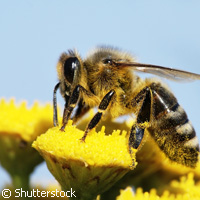Plastic for bees? Research shows it works
Technological advances are reaping good results for our world, and groups that are benefitting most from innovation are people and ... bees. Researchers in Germany have developed a better way of rearing bee larvae in the laboratory. Their method, presented in the journal Methods in Ecology and Evolution, will help scientists shed light on why the bee population is declining. It is well known that bees play a crucial role in securing food for humans, due to their outstanding pollination activities on plant crops. But the bee population is shrinking and researchers are on a quest to get to the bottom of this problem. A combination of various factors like agricultural chemicals, loss of habitat, and diseases are pushing scientists to kick-start the race and find a solution in a laboratory. Enter researchers from the University of Würzburg who came up with an innovative idea to rear honey bee larvae within a four-wall room; this would help them determine why the bee is dying. Existing laboratory rearing methods are lacklustre as they involve 'grafting', where the small first instar bee larvae (around 1 millimetre long) are collected using brushes, feathers or needles. As the pressure mounts to gather the information, mechanical stress grows, triggering mortality among the tiny larvae. 'To sustain the vital ecosystem service of pollination, new methodical developments are needed for research on the underlying factors of globally observed bee losses,' say the authors of the study. 'In particular, robust laboratory methods for assessing adverse effects on honey bee brood are required. In addition, from a statistical point of view, the shared origin of test individuals must be considered when analysing ecotoxicological data.' The researchers adopted a non-grafting method to collect honey bee larvae; this ensured no direct manipulation of the larvae. The team allowed the honey bee queens to lay eggs directly into an artificial plastic honeycomb about the size of a cigar box to ensure the larvae's safety. Professional honey bee queen breeders use the plastic honeycomb, and the researchers realised that these honeycombs facilitate their rearing of the larvae and guarantee positive results. 'The artificial comb has a hexagonal pattern with 110 holes the size of wax cells,' explains Harmen Hendriksma, lead author of the study. 'The queen lays her eggs directly into these small plastic cells. Because the back of each cell has a small plastic cup, we can collect the larvae without handling them.' Dr Hendriksma decided to use the plastic honeycomb in the laboratory following a stint with a Dutch company that produced honey for medical purposes. 'Like many people I am a bit lazy and wanted to find a quicker, easier way of rearing honey bees in the laboratory,' he says. 'When I tried using the plastic honeycomb system I found it was just perfect.' By using the plastic honeycomb, the team ensured the survival of 97% of the larvae and they successfully collected over 1 000 larvae in 90 minutes. This latest technique could also give the quality of bee research a boost, particularly because the results generated in various laboratories will be more directly comparable. The research findings also indicate that applying statistical approaches used in other areas of ecological science can give bee researchers the edge they need to get more positive analyses. 'Bee research is like an arms race, where researchers try and keep up with monitoring emerging new risks to bees,' Dr Hendriksma says. 'Because so many factors - such as environmental pollution, new agricultural pesticides, bee diseases, changing habitats and bees' genes - may be playing a part in the loss of our bees, we need better ways of analysing our results.'For more information, please visit: University of Würzburg:http://www.uni-wuerzburg.de/en/new/Methods in Ecology and Evolution:http://www.methodsinecologyandevolution.org/view/0/index.html
Countries
Germany



